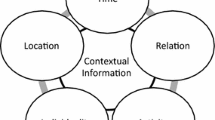Abstract
There is no denying that communication networks, in particular the Internet, have changed our lives in many ways. Many organizations and businesses in general benefit, but at the same time their communication networks face many challenges such as cyber-attacks, which can result in disruptions of services and huge financial losses. Therefore, resilience of these networks against cyber-attacks is a growing interest in the cyber security community. In this paper, we propose a framework for attack pattern recognition by collecting and correlating cyber situational information vertically across protocol-levels, and horizontally along the end-to-end network path. This will help to analyze cyber challenges from different viewpoints and to develop effective countermeasures.
Access this chapter
Tax calculation will be finalised at checkout
Purchases are for personal use only
Similar content being viewed by others
Notes
- 1.
Information Warfare Monitor, Tracking GhostNet: Investigation Cyber Espionage Network. March 29, 2009. http://www.infowar-monitor.net/2009/09/tracking-ghostnet-investigating-a-cyber-espionage-network/
- 2.
MITRE manages federally funded research and development centers (FFRDCs), partnering with government sponsors to support their crucial operational mission. CAPEC- CybOX is managed by MITRE http://www.mitre.org/
- 3.
ResumeNet: http://comp.lancs.ac.uk/resilience/
References
Rinalid SM, Peerenboom JP, Kelly TK. Identifying, understanding and analyzing critical infrastructure interdependencies. IEEE Control Syst Magaz. 2001;21(6):11–25. doi:10.1109/37.969131.
Smith P, Hutchison D, Schöller M, Fessi A, Karaliopoulos M, Lac C, Plattner B. Network resilience: a systematic approach. IEEE Commun Magaz. 2011;49(7):88–97. doi:10.1109/MCOM.2011.5936160.
Computer Crime Research Center. Cybercrime is an organized and sophisticated business. 2001. http://www.crime-research.org/library/Cybercrime.htm. Accessed Sept 2013.
Gamma E, Helm R, Johnson R, Vlissides J. Design patterns: elements of reusable object-oriented software. Inc, Boston, MA, USA: Addison-Wesley Longman Publishing Co.; 1995.
Jain AK, Murty MN, Flynn PJ. Data clustering: a review. ACM Comput Surv. 1999;31(3):264–323. doi:http://doi.acm.org/10.1145/331499.331504 NULL.
Pavan M, Pelillo M. A new graph-theoretic approach to clustering and segmentation. In: Proceedings of the IEEE conference on computer vision and pattern recognition, Madison, Wisconsin, USA. doi:10.1109/CVPR.2003.1211348; 2003. pp. 145–152.
Tan P-N, Steinbach M, Kumar V. Introduction to data mining. Inc, Boston, MA, USA: Addison-Wesley Longman Publishing Co.; 2005.
Adrian F, Rehnhard M. Histogram matrix:Log visualization for anomaly detection. In: Proceedings of the third international conference on availability reliability and security, Barcelona, Spain; 2008. pp 610–617.
Kind A, Stoecklin MP, Dimitriopoulos X. Histogram based traffic anomaly detection. IEEE Trans Netw Serv Manage. 2009;6(2):110–121. doi:10.1109/TNSM.2009.090604.
Nousiainen S, Kilpi J, Silvonen P, HiirsalmiSami M. Anomaly detection from server log data. A Case Study. Tech. rep., VTT Research Notes. http://www.vtt.fi/inf/pdf/tiedotteet/2009/T2480.pdf (2009).
Barnum S, Sethi A. An introduction to attack patterns as a software assurance knowledge resource. Tech. rep., Cigital Inc. http://capec.mitre.org/documents/Attack_Patterns-Knowing_Your_Enemies_in_Order_to_Defeat_Them-Paper.pdf (2007).
Barnum S. Common attack pattern enumeration and classification (CAPEC) schema description. Tech. rep., Cigital Inc. http://capec.mitre.org/documents/documentation/CAPEC_Schema_Description_v1.3.pdf (2008).
Gu G, Perdisci R, Zhang J, Lee W. BotMiner: Clustering analysis of network traffic for protocol- and structure-independent botnet detection. In: Proceedings of the 17th USENIX security symposium. San Jose: CA, USA; 2008. pp. 139–154.
Varrandi R. SEC—a light weight event correlation tool. In: Proceedings of the IEEE workshop on IP operations and management. doi:10.1109/IPOM.2002.1045765; 2002. pp. 111–115.
Staniford S, Hoagland JA, McAlerney JA. Practical automated detection of stealthy portscans. J Comput Secur. 2002;10(1–2):105–36.
Staniford-Chen S, et al. GrIDS—A graph based intrusion detection system for large networks. In: Proceedings of the 19th national information systems security conference; 1996. pp. 361–370.
Roesch M. SNORT—Lightweight intrusion detection for networks. In: Proceedings of the USENIX technical program - 13th systems administration conference - LISA ’99. Washington, USA: Seattle; 1999. p. 229–238.
The Team Cymru. Home page of The team Cymru darknet. http://www.team-cymru.org/Services/darknets.html. (2009). Accessed Sept 2013.
Bailey M, Cooke E, Jahanian F, Nazario J, Watson D. The Internet motion sensor: a distributed blackhole monitoring system. In: Proceedings of the 12th annual network and distributed system security symposium (NDSS), San Diego, CA, USA; 2005.
Shannon C, Moore D. The spread of the witty worm. IEEE Secur Priv. 2004;2(4):46–50. doi:10.1109/MSP.2004.59.
Staniford S, Moore D, Paxson V, Weaver N. The top speed of flash worms. In: Proceedings of the ACM workshop on rapid malcode, WORM 2004, Washington, DC, USA; 2004.
Pang R, Yegneswaran V, Barford P, Paxson V, Peterson L. Characteristics of Internet background radiation. In: Proceedings of the 4th ACM SIGCOMM, Taormina, Sicily, Italy; 2004. pp. 27–40. doi:10.1145/1028788.1028794.
ArborNetworks. Estonian DDoS attacks-A summary to date. Tech. rep., Arbor Networks. http://asert.arbornetworks.com/2007/05/estonian-ddos-attacks-a-summary-to-date/ (2007).
Pratt VR. Modeling concurrency with partial orders. Int J Parallel Prog. 1986;15(1):33–71. doi:10.1007/BF01379149.
Yu Y, Fry M, Schaeffer-Filho A, Smith P, Hutchison D. An adaptive approach to network resilience: evolving challenge detection and mitigation. In: 2011 8th International workshop on the design of reliable communication Networks (DRCN). doi:10.1109/DRCN.2011.6076900; 2011. pp 172–179.
Sterbenz JPG, Hutchison D, Çetinkaya EK, Jabbar A, Rohrer JP, Schöller M, Smith P. Resilience and survivability in communication networks: strategies, principles, and survey of disciplines. Comput Netw. 2010;54(8):1245–1265. doi:10.1016/j.comnet.2010.03.005.
Acknowledgments
This research is partially supported by the EPSRC funded India-UK Advanced Technology Centre in Next Generation Networking.
Author information
Authors and Affiliations
Corresponding author
Editor information
Editors and Affiliations
Rights and permissions
Copyright information
© 2014 Springer International Publishing Switzerland
About this chapter
Cite this chapter
Shirazi, Nuh., Schaeffer-Filho, A., Hutchison, D. (2014). Attack Pattern Recognition Through Correlating Cyber Situational Awareness in Computer Networks. In: Blackwell, C., Zhu, H. (eds) Cyberpatterns. Springer, Cham. https://doi.org/10.1007/978-3-319-04447-7_10
Download citation
DOI: https://doi.org/10.1007/978-3-319-04447-7_10
Published:
Publisher Name: Springer, Cham
Print ISBN: 978-3-319-04446-0
Online ISBN: 978-3-319-04447-7
eBook Packages: Computer ScienceComputer Science (R0)




